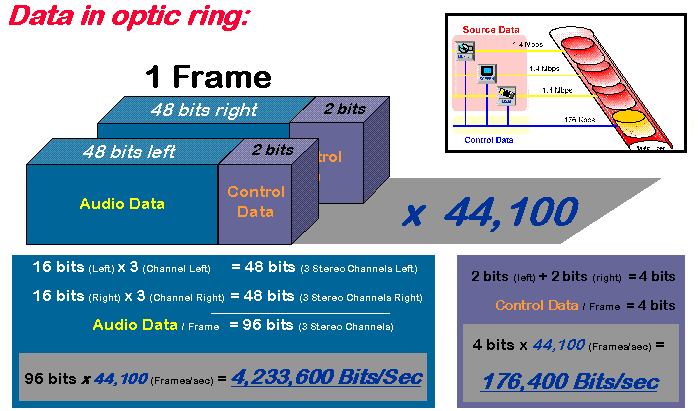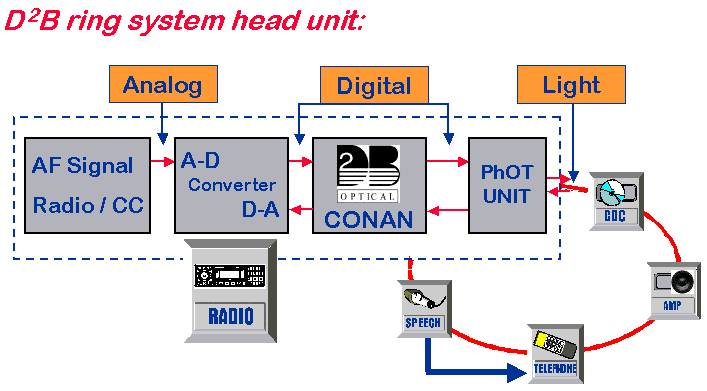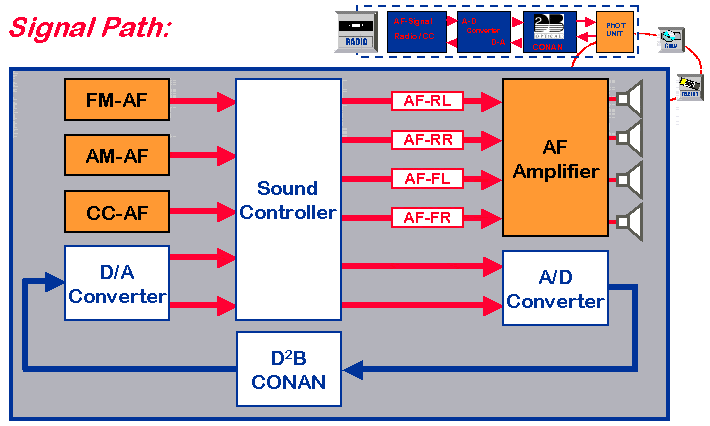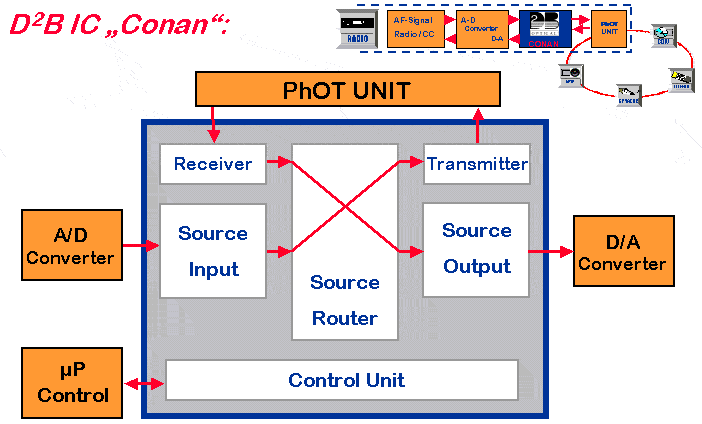D2B Optic Bus
The data is sent around the ring in packets, or frames. The synchronisation of these frames is crucial and by combining the signal data and control data together, this is easily achieved. The sampling frequency was chosen at 44.1 kHz, the same as normal music CD's. In fact very little process of the signal is required from audio CD's to interface their signal with the D2B system.
Each frame is comprised of two blocks, each carrying 48 bits of audio information from either the left or right audio channels. Along with this is 2 bits of control data. These frames are transmitted 44,100 time every second! The 48 bits of audio in each block is made up of the 16 bits of audio, again straight from the CD standard. As you can see below, 3 x 16 bits = 48 bits; then this is multiplied by two for the two channels (left & right). 2 x 48 bits = 96 bits.
The control data follows the same calculation process. Each block carries 2 bits of control data, hence 4 bits with each frame. Hence the total data stream can easily be calculated by multiplying by 44,100. For the audio stream this gives 4,233,600 bits per second and for the data stream a figure of 176,400 bits per second is obtained. In total there are about 4.41 million bits being transmitted through the D2B fibre optic cable every second!

Inside the head unit or radio, we find several sections which work together with the D2B system. Several sections are analog and others are digital. It is important to realise that the D2B only works in the digital domain, so any analog signals must be converted into digital before they can be transmitted through the optic cable. This is carried out by the ADC, or Analog to Digital converter. Conversely another section of the circuit exists which can do the conversion from digital to analog in the opposite direction. This is known as a DAC, or Digital to Analog Converter. AM, FM and cassette audio signals are all analog, so they feed into the ADC to be converted into digital. The next step is the CONAN chip. This is the heart of the system and we will be looking at it in greater detail further below. To send signals which are electrical in wires or circuit tracks inside the radio, to the optical cable requires another conversion. This is handled by the PhOT unit (Photo Optical Transmitter). It is also capable of receiving optical signals. It works simply by converting the electrical signals into very fast pulses of light. You cannot see these high speed pulses but you may be able to see the red glow!

The signal path can be easily shown in the diagram below. As mentioned, the AM, FM and tape are all analog. The amplifier section is also analog. This is where the ADC and DAC come into play. They can convert the signals appropriately as required from analog to digital or visa versa. The Sound Controller is a chip which selects what you decide to listen to. When you select FM for instance, it channels the audio signal from the FM section of the radio to the amplifier. If you select the CD Changer, the system needs to get the signal from outside the unit. This is where the PhOT and CONAN come into play. The CD Changer is sent a control signal to start playing through the D2B cable. The audio signal is digital of course and travels back to the radio. The CONAN chip handles the interface and sends the digital audio signal to the DAC (Digital to Analog Converter). It comes out as an analog signal which the Sound Controller sends to the internal amplifier so you can hear it! The Sound Controller also handles such things as volume, balance and treble / bass.

The CONAN integrated circuit (IC or chip), is the heart of the D2B system. It decides what to do based on the user selecting different modes of operation plus what sort of devices are connected. When switch on of the radio occurs, the CONAN IC checks the system by sending 4 pulses around the optic cable and then receives data back, letting it know what is connected. Not all systems have all the possible devices connected. If there is no external amplifier, then there is no need to send audio data out, instead it is routed direct to the internal amplifier of the radio. A control unit inside the CONAN IC interfaces with the radio's microprocessor (uP). The uP tells CONAN what to do based on the above parameters. The Source Router operates like railways points, directing the signal to the appropriate location. This all happens in real time and extremely fast, you don't realise what is happening!

